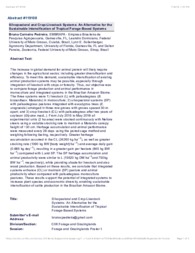Silvopastoral and crop-livestock systems: an alternative for the sustainable intensification of tropical forage-based systems.
Silvopastoral and crop-livestock systems: an alternative for the sustainable intensification of tropical forage-based systems.
Autoria: PEDREIRA, B. C. e; DOMICIANO, L.; SOLLENBERGER, L. E.; PEREIRA, D.
Resumo: The increase in global demand for animal protein will likely require changes in the agricultural sector, including greater diversification and efficiency. To meet this demand, sustainable intensification of existing animal production systems may be possible, especially through integration of livestock with crops or forestry. Thus, our objective was to compare forage production and animal performance in monoculture and integrated systems in the Brazilian Amazon Biome. The three systems were 1) livestock (L) with palisadegrass (B. brizanthacv. Marandu) in monoculture; 2) silvopastoral systems (SP) with palisadegrass pastures integrated with eucalyptus trees (E. urograndis) arranged in three-row groves with groves spaced 30-m apart; and 3) crop-livestock (CL) with palisadegrass after two years of soybean (Glycine maxL.). From July 2015 to May 2018 all experimental units (2 ha area) were stocked continuously with Nellore steers using a variable stocking rate to maintain a Marandu canopy height of ~30 cm. Herbage accumulation and animal performance were measured every 28 days using the paired cage method and weighing following fasting, respectively. Greater herbage accumulation occurred in the CL (24260 kg ha?1), as well as greater stocking rate (1390 kg BW [body weight] ha?1) and average daily gain (0.685 kg day?1), resulting in a greater gain per hectare (845 kg BW ha?1) compared with L and SP. The SP herbage accumulation and animal productivity were similar to L (15520 kg DM ha?1and 750kg BW ha?1, respectively), while providing shade for livestock and also wood production. Based on these results, we conclude that integrated systems enhance (CL) or maintain (SP) pasture and animal productivity when compared with palisadegrass monoculture pastures. These results support the potential of integrated systems to increase plant species and economic diversity, enabling sustainable intensification of cattle production in the Brazilian Amazon Biome.
Ano de publicação: 2019
Tipo de publicação: Resumo em anais e proceedings
Unidade: Embrapa Agrossilvipastoril
Palavras-chave: Animal proteins, Mato Grosso, Silvopastoral systems, Sinop-MT
Observações
1 - Por padrão são exibidas publicações dos últimos 20 anos. Para encontrar publicações mais antigas, configure o filtro ano de publicação, colocando o ano a partir do qual você deseja encontrar publicações. O filtro está na coluna da esquerda na busca acima.
2 - Para ler algumas publicações da Embrapa (apenas as que estão em formato ePub), é necessário ter, no celular ou computador, um desses softwares gratuitos. Sistemas Android: Google Play Livros; IOS: iBooks; Windows e Linux: software Calibre.
Acesse outras publicações
Acesse a Base de Dados da Pesquisa Agropecuária (BDPA) para consultar o acervo completo das bibliotecas da Embrapa.

